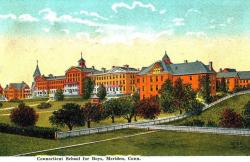Connecticut School for Boys
| Connecticut School for Boys | |
|---|---|
 | |
| Established | 1851 |
| Opened | 1854 |
| Closed | 1972 |
| Current Status | Closed |
| Building Style | Cottage Plan |
| Location | Meriden, CT |
| Alternate Names |
|
History[edit]
The Meriden School for Boys was opened in March 1854, three years after the legislature authorized creation of a reform school for boys in 1851. This authorization followed a select legislative committee's report in 1850 that called for establishing a school for the “instruction, employment, and reformation of juvenile offenders.” It estimated that at least 200 boys a year could be classified as juvenile offenders who might be sent to the school. The legislature's actions were part of a national movement to find an alternative to imprisoning juveniles with adults.
The legislature appropriated $10,000 to establish the school, but these funds could not be spent until individuals contributed a matching amount. This was accomplished within a few years, and the school was
It opened in 1854 with 139 boys. Boys under age 16 who committed crimes could be committed to the school for a definite sentence, until they were reformed, or until they turned age 21. Over half of the boys in the school in 1856 had lost one or both parents, over half had either one or both parents deemed intemperate, and 20% had one or both parents in jail.
An eight-member board of trustees appointed by the legislature governed the school. The board hired the school's employees, which included a superintendent to administer daily operations, academic and vocational instructors, a chaplain, a steward, watchmen, and a farmer. The trustees could apprentice boys to farmers and mechanics; most of the boys who were discharged from the school left in this way. They could also remand incorrigible boys to a county sheriff or town constable for placement in a prison, jail, or workhouse.
The trustees intended the school to be a family as well as a school of detention and reformation. The boys worked six hours a day; spent four in school; prayed, played, or performed incidental duties for five hours; and had nine hours for sleep. They were housed in dormitories that were secured at night. The school's punishment philosophy called for graduated sanctions that began with denying recreation and rose, “when absolutely necessary,” to beating.
In 1921 Public Acts Chapter 336 set up the Juvenile Court System; the School for Boys and Long Lane School became juvenile detention centers for persons committed by the Juvenile Courts. By 1970, January 2, Public Act 69-664 it became part of the new Department of Children and Youth Services for administrative purposes. Permission given in 1972 for the Commissioner of Children and Youth Services to merge with Long Lane School; all residents moved to Middletown, the Meriden facility closed.